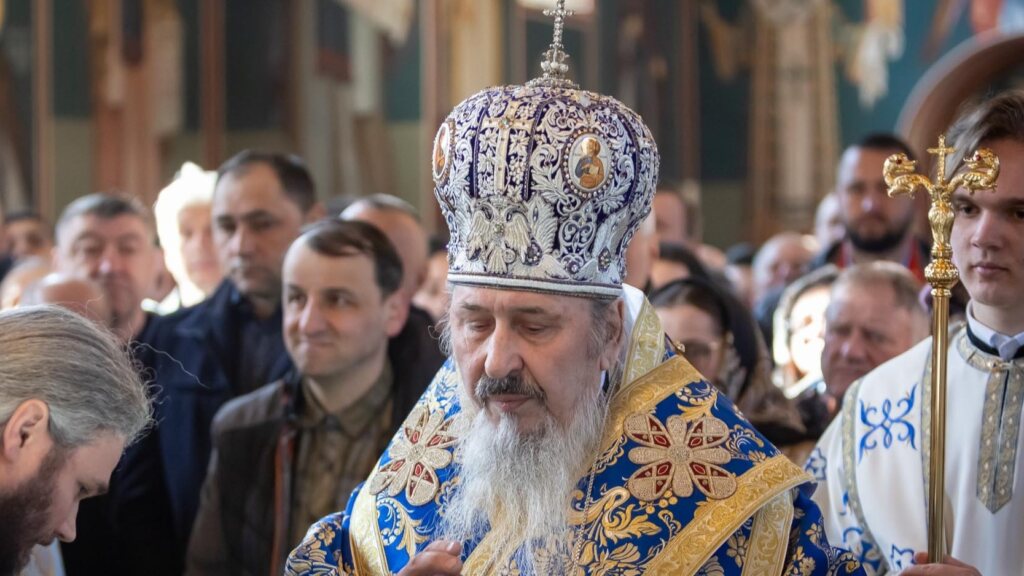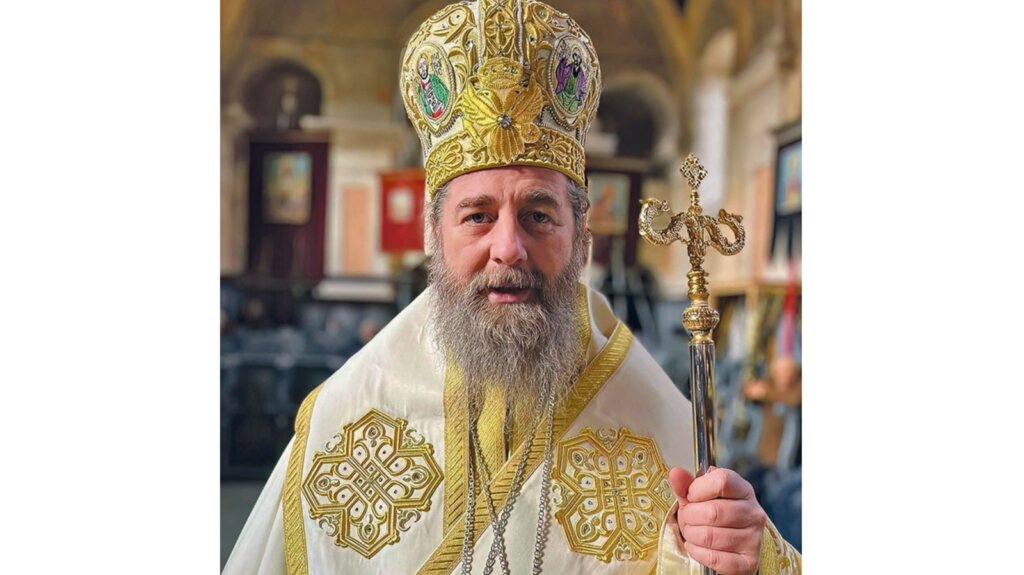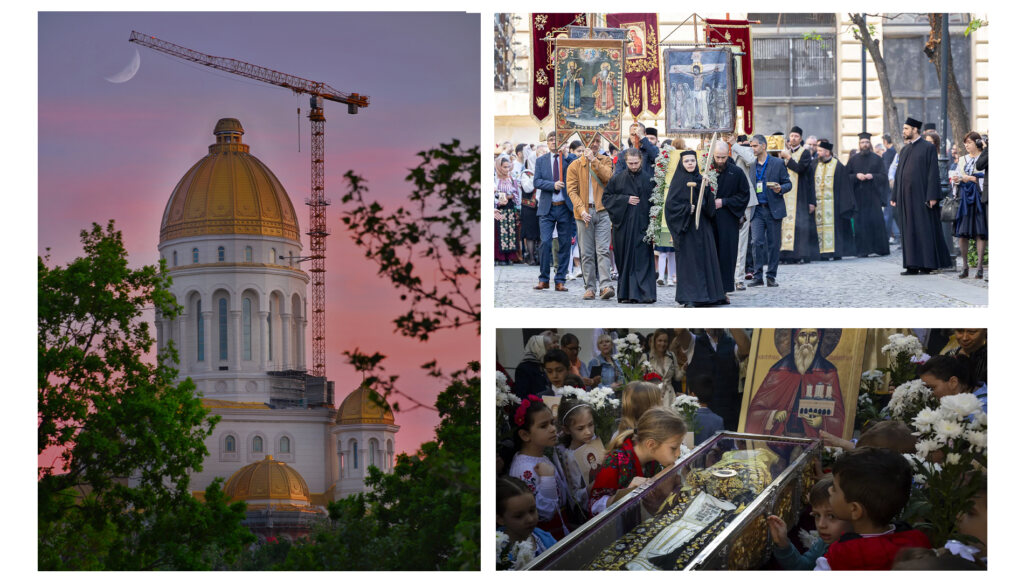Holy Apostle Andrew the First-Called
He was the first of the Apostles to follow Christ, and he later brought his own brother, the holy Apostle Peter, to Christ (John 1:35-42). The future apostle was from Bethsaida, and from his youth he turned with all his soul to God. He did not enter into marriage, and he worked with his brother as a fisherman.
When the holy Prophet, Forerunner and Baptist John began to preach, Saint Andrew became his closest disciple. Saint John the Baptist himself sent to Christ his own two disciples, the future Apostles Andrew and John the Theologian, declaring Christ to be the Lamb of God.
After the Descent of the Holy Spirit upon the Apostles, the Church Tradition says the apostles cast lots as to where to preach. The cast were for him to preach in Bithynia and Pontus Euxinus (along the Black Sea shore) up to Scythia, on the Danube. He preached to the Geto-Dacian tribes, to the Roman and the Greek he found along the River Danube.
Most historical sources mention his mission on the Western part of Pontus Euxinus (the Black Sea). The writings of Saint Hippolytus, Bishop of Rome, Origenes and Eusebius of Caesarea mention that the Holy Apostle Andrew preached to the Scythians and Thracians. He went to both Scythia Major (the southern part of today’s Ukraine) and Scythia Minor (today’s Romanian province of Dobrudja).
After he left Dobrudja, Holy Ap. Andrew went south, ordaining St. Amplias, one of the 70 disciples, as Bishop of Odessos (today’s Bulgarian city of Varna, on the Black Sea coast). He further preached in Thracia and Byzantium, where he ordained St. Stachis as a Bishop, and in Macedonia, where he ordained St. Urban as bishop. These disciples of St. Andrew are celebrated on October 31.
The final city to which the Apostle came was the city of Patras, where he was destined to suffer martyrdom.
The Lord worked many miracles through His disciple in Patras. The infirm were made whole, and the blind received their sight. Through the prayers of the Apostle, the illustrious citizen Sosios recovered from serious illness; he healed Maximilla, wife of the governor of Patras, and his brother Stratokles. The miracles accomplished by the Apostle and his fiery speech enlightened almost all the citizens of the city of Patras with the true Faith.
Few pagans remained at Patras, but among them was the prefect of the city, Aegeatos. The Apostle Andrew repeatedly turned to him with the words of the Gospel. But even the miracles of the Apostle did not convince Aegeatos. The holy Apostle with love and humility appealed to his soul, striving to reveal to him the Christian mystery of life eternal, through the wonderworking power of the Holy Cross of the Lord. The angry Aegeatos gave orders to crucify the apostle.
He was crucified on a cross made of olive wood in the shape of X. Afterwards, this type of cross has been named “St. Andrew’s Cross”. Some think he was martyred during Nero’s reign (54-68), other during Emperor Domitian (81-96).
His holy relics were moved to Constantinople in 357, but the saint’s head was sent back to înapoi Patras in the 9th century. After Constantinople was conquered by the crusaders (in 1204), his holy relics were taken to Amalfi, in Italy, and in 1460 his holy head was taken to Rome to protect it from the pagans. In 1964, the Holy See of Vatican sent back his head to Patras as a sign of Christian fraternity.
Since Holy Apostle Andrew brought Christianity to the Romanians’ ancestors living in Dobrudja, the Romanian Orthodox Church grants the saint special honours, considering him as its founder. In 1995 the Holy Synod of the Romanian Orthodox Church decided to write his feast day in the Orthodox Calendar in red.
The Holy Synod of the Romanian Orthodox Church proclaimed Holy Apostle Andrew as Protector of Romania in February 1997 and in 2002 it declared its feast day as the National Feast Day of the Church.
In 2012, the Romanian Parliament declared the day of the Holy Apostle Andrew’s feast, November 30, as a national holiday. As an homage to the saint, one of the newly-built National Cathedral‘s patronal feasts is Holy Apostle Andrew. The Other patronal feast is the Lord’s Ascension, which is the Day of the Romanian Heroes.
For St. Andrew’s prayers, your first-called apostle, Lord Jesus Christ, our God, have mercy on us. Amen.
Troparion — Tone 4
Andrew, first-called of the Apostles / and brother of the foremost disciple, / entreat the Master of all / to grant peace to the world / and to our souls great mercy.

Holy Hierarch Andrei Şaguna, metropolitan of Transylvania
He was born to parents obedient to God, whose ancestors were “Wallachians” or “Aromanians”, living in the Balkans, who took refuge, in the 18th century, to a few Christian countries of the Austrian Empire, because of the Turkish occupation. When Anastasios, the future hierarch of Transylvania, was born, Şaguna family was in the city of Miskolc, in the north-eastern part of Hungary. It was close to Christmas, in 1808.
His brave mother, Anastasia, gave her name to the new born child, which means “resurrection”. A few years after Anastasios was born, his father passed away. Thus, Anastasia Şaguna was facing the troubles of life with three children: Evreta, Ecaterina and Anastasios, who were orphans now, after their father died. Faced with great material needs, she succeeded in making them obedient to God and observant of the holy Orthodox traditions.
Anastasios was sent to study at the best schools of the time: the “Greek-Wallachian” elementary school of Miskolc supported by the Aromanian parish over there, the “inferior” secondary school of Miskolc, the “superior” secondary school (high school) of Pest (today’s Budapest), then at the university in that city, where he brilliantly studied philosophy and law.
When he finished his studies, young Anastasios could have benefited of a nice career as lawyer, judge or professor. But, urged by his religious mother, he left for Vârşeţ (in today’s Serbian Banat) and enrolled at the Romanian-Serbian Theological Seminary over there. After graduation, he joined the community of the Serbian Hopovo Monastery, where he asked to be tonsured into monasticism before he was 25 years old.
He was given the name of Saint Andrew the Apostle, the first called. He was an educated monk, with studies in law, philosophy and theology, with a good command of Romanian (including the Aromanian dialect), Hungarian, German, Serb, Greek, Latin and Slavonic. Nevertheless, the new soldier in the service of Christ, our Lord, grew in humbleness and prayer, working in time and no time to acquire virtues, in devotion and pure prayer, improving spiritually and rising to the likeness of God through knowledge.
He was very appreciated by the Serbian Orthodox hierarchs, who asked him to leave the peacefulness and quietness of the monastery and activate within the Metropolitanate of Karlovci. He obeyed and responded to this call and for 13 years he worked as rector, counsellor, metropolitan, seminary professor and as igumen at four Serbian monasteries (Jazak, Bešenovo, Hopovo and Kovilje).
In the summer of 1846, the metropolitan of Karlovci appointed him “general vicar” to the vacant Romanian Diocese of Transylvania, seated in Sibiu; in December 1847, the “assembly” of the Transylvanian archpriests proposed him bishop, having been confirmed by the imperial Court of Vienna and ordained hierarch by the metropolitan of Karlovci, on Thomas’ Sunday, in 1848.
He left for Sibiu just on the day of his ordination, where the Orthodox Romanians were waiting for him as for a redeemer. He engaged directly and with much devotion in all the actions of rehabilitation of the cultural and spiritual identity of the Transylvanian Romanians, first of all to recognise them as “nation” equal in rights with the Hungarians, Saxons and Székelys and to abolish serfdom.
From a religious point of view, Metropolitan Andrei Şaguna fought with much courage for over 15 years, for taking the Romanian Church of Transylvania from under the jurisdiction of the Serbian Metropolitanate of Karlovci, where the imperial Court of Vienna abusively put it. He won and this fight was crowned in December 1864, when the restoration of the old Metropolitanate of Transylvania was approved (dissolved in 1701 by the state authorities of the time), and Andrei Şaguna became archbishop of Sibiu and metropolitan of the Romanians in Transylvania, Banat, and of the “Western parts” (Crişana).
Then, he worked out a law known as the Organic Statute, approved by a Church National Congress in 1868, which stipulated the autonomy of this Church in relation to the state, as well as the participation of the lay people in the leadership of church life, in the administrative and economical fields. The Church of Transylvania was run in accordance with this statute until 1925, but the basic principles have been kept in the following Statutes too, up to the present.
Metropolitan Andrei was a true “founder” of the Romanian education and culture of Transylvania. He re-organised the old theological school of Sibiu as Theological Pedagogical Institute, with two “sections”, where the future priests were prepared, as well as the teachers of about 800 primary schools of Transylvania, supervised by the Church (more than half set up in his time).
He has also organised the eight forms secondary school of Braşov (the present “Andrei Şaguna” College), a secondary school in Brad, county of Hunedoara, a “real-commercial” school in Braşov, and courses for the illiterate people of every parish.
He set up a “diocesan publishing house” in Sibiu, where he printed “Telegraful român” newspaper (uninterruptedly published from January 1853 until today), the eparchial “Calendar” (today’s “Îndrumătorul bisericesc”, since 1852 until today), a series of manuals for the primary schools, as well as for the theological education (some of them drafted by himself), all the liturgical books, some of them in several editions, a new edition of the Bible, in 1856-1858, etc.
It was also Şaguna who obtained the agreement of the authorities to set up the Transylvanian Association for the Literature and Culture of the Romanian People (ASTRA). He granted scholarships from the Archdiocese’s funds to the young people who were attending secondary and academic studies, who formed the intellectual elite of Transylvania of the time.
He organised the present metropolitan residence of Sibiu, founded the church of Guşteriţa (a district of Sibiu today) and urged the priests and faithful to contribute with money and physical work to the construction of churches and school buildings. He was going to build a cathedral in Sibiu, but he could not collect the money necessary for beginning the construction. He was a great man of prayer and fasting, a perfect celebrant, preacher and shepherd of souls, who has always been in touch with the clergy and faithful.
He passed away on 16/28 June 1873, and he was buried near the big church of Răşinari, as he mentioned in his will, the funeral service being officiated by only one priest, “without sermon and pomp”. In spite of his true monastic humbleness, the righteous people properly honoured him also after his death, considering him one of the most outstanding hierarchs of Transylvania.
The Holy Synod of the Romanian Orthodox Church placed him among the saints on 21 July 2011, celebrated on 30 November.
Through his holy prayers, Lord Jesus Christ, our God, have mercy on us. Amen.
Troparion
Tone 4:
Wise protector of Orthodox Romanians, lettered shepherd of Transylvania and great administrator of the church life, oh, Saint Hierarch Andrei, pray to Christ our God to save our souls.

Saint Frumentius, Archbishop of Inda (Ethiopia, formerly Abyssinia)
He was a native of the city of Tyre. While still a child, he came to Abyssinia by divine Providence. Growing up near the imperial court, he became a friend and chief counselor of the Abyssinian emperor, and afterwards tutor to his son, who ascended the throne while still a minor after the death of his father.
With the consent of the new emperor, Saint Frumentius journeyed to his native land and afterwards visited Alexandria and its patriarch, Saint Athanasius the Great (May 2). With the blessing of Saint Athanasius, Frumentius was elevated to become Bishop of Abyssinia and he returned to that country, which had sheltered him from his childhood.
After he returned from his consecration, Saint Frumentius began to perform miracles, bringing many people to the Church. The emperor said to him, “You have lived among us for many years, yet we never saw you perform such wonders. Why is it that you do so now?” The saint replied, “This has nothing to do with me, but is due to the grace of the priesthood.” Then the emperor and many of his subjects received holy Baptism.
Having accomplished the apostolic task of converting the Abyssinian nation to Christ, Saint Frumentius zealously and fruitfully guided the Church entrusted him by God for many years, then peacefully departed to the Lord in great old age.

Tr by oca.org






